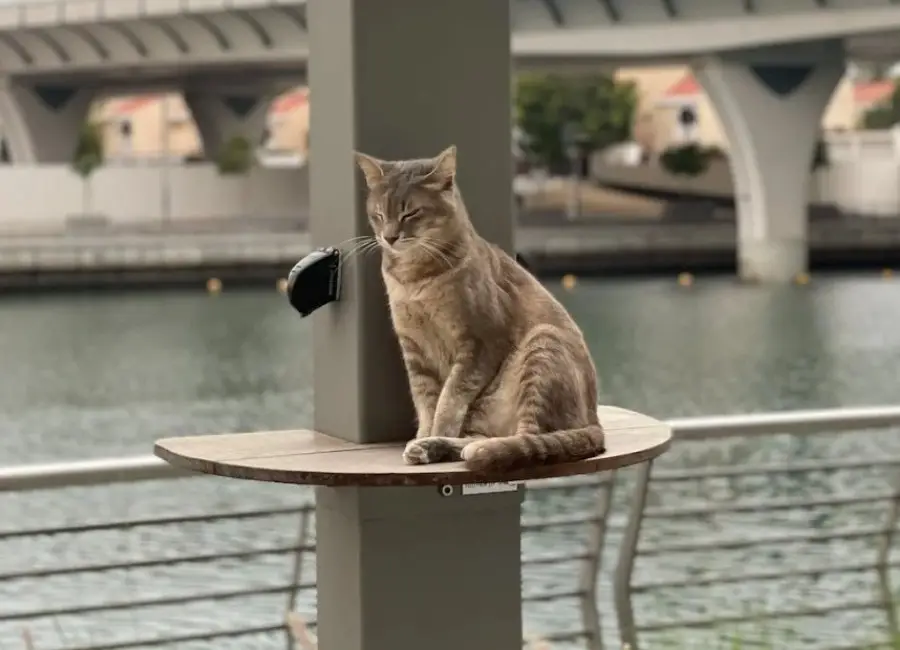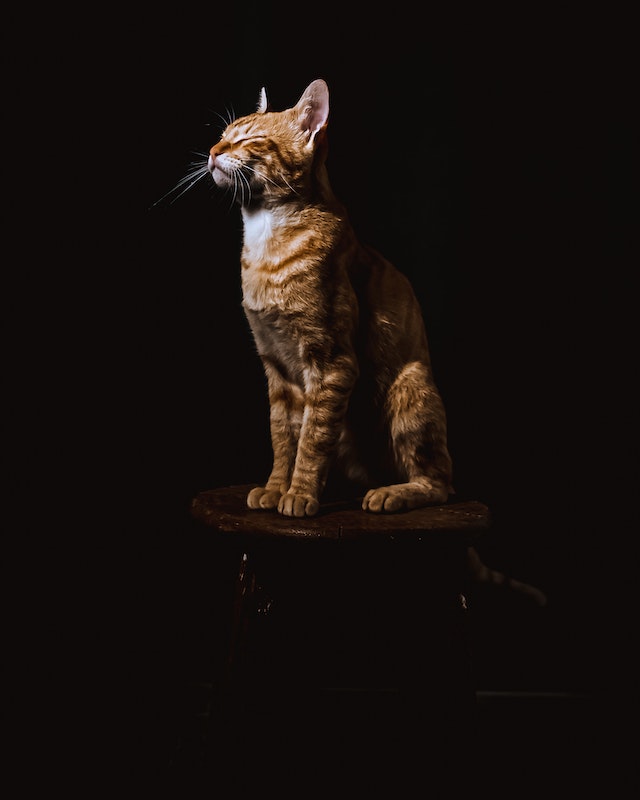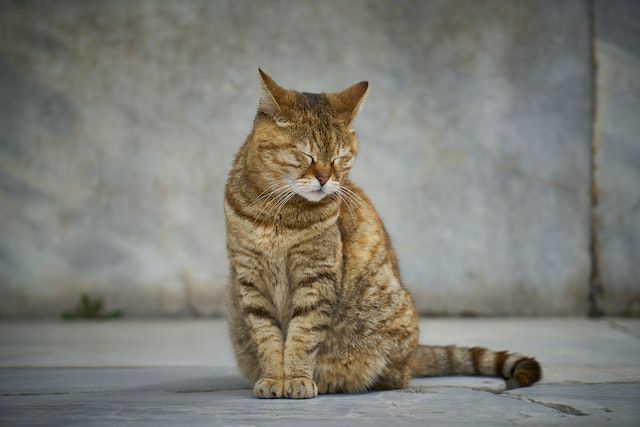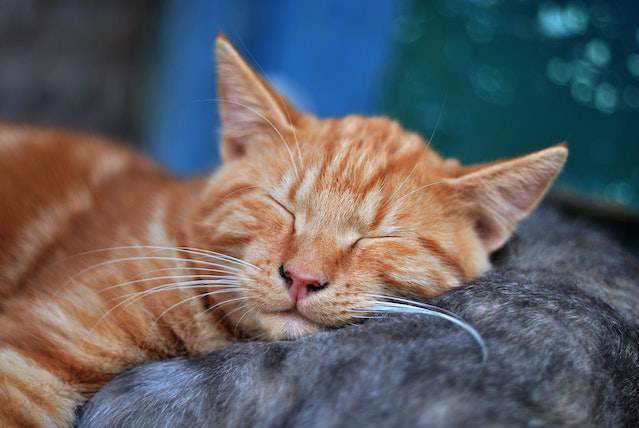9 Potential Reasons Your Cat Sleeps Sitting Up

Let’s discuss some potential reasons your cat sleeps sitting up…
Have you ever caught your furry friend in the act of slumber, only to be surprised by their strange sleeping position? Well, picture this: imagine walking into a room and seeing your cat taking a nap… while sitting up!
It might seem weird at first but fear not, because today we’re diving into the fascinating phenomenon of cats sleeping in an upright position. From the reasons behind it to the science behind their impeccable balance, we’ve got all the juicy details coming your way!
Why Do Cats Sleep Sitting Up
Cats sleep sitting up to help them conserve energy and be prepared for any potential threats or opportunities that may arise, sleeping sitting up can also provide cats with a better vantage point to observe their surroundings.
Cats have the ability to sleep sitting up due to their unique anatomy and muscle structure. This allows them to rest while maintaining a high level of alertness.
Keep in mind that sleeping in a seated position also helps them conserve energy while still being aware of their surroundings, making it advantageous for survival in the wild.
This behavior may also have evolved from their ancestors, who needed to stay vigilant even while resting.
Let’s dive deeper for a better understanding…
Potential Reasons Cat Sleeps Sitting Up

The following are some common reasons why cats may choose to sleep sitting up:
1. Vigilance and Safety
Cats are highly alert and cautious animals, a trait that stems from their wild ancestors. In the wild, they constantly face the threat of predators, which makes it essential for them to stay vigilant even during sleep.
Sleeping while sitting up allows them to maintain a level of awareness about their surroundings, making it easier for them to detect potential dangers. By keeping their senses sharp, they can quickly respond to any perceived threats, ensuring their safety and survival.
2. Quick Escape
Cats are agile and nimble creatures, and their ability to escape quickly is a crucial survival skill. Whether in the wild or in a domestic setting, cats may encounter situations where they need to flee suddenly.
By sleeping in a sitting position, they are poised for action, ready to spring into action and make a swift escape if necessary. This behavior is deeply ingrained in their instincts and provides them with a better chance of evading danger.
3. Sleep Cycle Variability
Like humans, cats experience different sleep stages during their rest. These stages include both light sleep and deep sleep.
During lighter stages of sleep, a cat might choose to sleep while sitting up as a way to maintain some level of alertness while still getting some rest.
As they transition into deeper sleep stages, they might feel more at ease lying down in a more traditional sleeping position.
4. Uninterrupted Rest
Cats are masters at finding cozy spots to rest and sleep. By sleeping while sitting up, they can easily find comfortable places even in small spaces or confined areas.
This ability to rest without lying down fully allows them to remain undisturbed and unaffected by minor disturbances in their environment. Cats are skilled at adapting to various situations, and this behavior demonstrates their resourcefulness in seeking out restful spots.
5. Comfort Preference
Each cat has its own unique personality and preferences, and this includes their preferred sleeping positions. Some cats may simply find it more comfortable to sleep while sitting up.
The reasons behind this preference could be related to their unique anatomy, such as the positioning of their muscles and joints. Alternatively, it may be a personal comfort choice, as cats are known for their independent and quirky nature.
6. Catnap Convenience
Cats are crepuscular animals, meaning they are most active during dawn and dusk. They are known for their tendency to take short, frequent naps throughout the day.
Sleeping in a sitting position allows them to quickly doze off and awaken, which is particularly useful for their survival in the wild. This behavior also aligns with their energy conservation strategy, allowing them to rest in short bursts and be ready for any opportunities that arise.
7. Temperature Regulation
Cats are known for their sensitivity to temperature changes. Unlike humans, they don’t rely on sweating to cool down. Instead, they have developed various ways to regulate their body temperature.
When they sleep sitting up, air can circulate more effectively around their bodies, helping them dissipate excess body heat in warm conditions. Similarly, in colder environments, this position allows them to conserve heat by minimizing contact with colder surfaces. It’s a clever adaptation that aids their thermoregulation process.
8. Injury or Pain

Cats are masters at masking pain, a survival strategy inherited from their wild ancestors. If a cat is experiencing any discomfort or pain, they might adopt a seated sleep position to avoid putting pressure on sensitive areas.
This behavior allows them to rest while minimizing any potential pain they might feel in their body, making it easier for them to cope with their discomfort.
9. Digestion Aid
After a meal, cats might experience some discomfort due to a full stomach. In some cases, they may prefer to sleep while sitting up, as it can relieve pressure on their abdomen.
This position might offer relief from any bloating or indigestion they may be experiencing, contributing to a more peaceful rest after a satisfying meal.
Learn more about why your cat is sleeping on your legs in bed.
Other Cat Sleeping Positions
Cats have a knack for finding cozy and comfortable places to sleep, and they often adopt various sleeping positions that can reveal their mood, health, and personality. Here are some common sleeping positions for cats:
- The Curl Up: This is one of the most classic cat sleeping positions. The cat curls up into a tight ball, protecting its vital organs and conserving body heat. It’s a sign that the cat feels safe and secure.
- The Stretch: Cats love to stretch out when they sleep. They extend their bodies and limbs, sometimes even stretching their paws and claws. This position helps them relax their muscles and release tension.
- The Belly-up: When a cat sleeps on its back, exposing its belly, it’s a sign of extreme trust and comfort. This position allows cats to cool down and show vulnerability.
- The Side Sleeper: Cats that sleep on their sides are signaling that they are relaxed and feel secure in their environment. It’s also a position that allows for easy and quick movement if needed.
- The Loaf: In this position, the cat tucks all its legs underneath its body, resembling a loaf of bread. It’s a common sleeping position and can indicate that the cat is in a deep sleep and feels content.
- The Donut: Some cats will curl up into a circular shape while sleeping, forming a donut-like position. This position helps cats feel secure and provides warmth and coziness.
- The Sphinx: Cats that sleep in the Sphinx position lie on their bellies with their front legs stretched forward. This position allows for quick reaction and is often seen in cats that are alert and ready to pounce.
- The Head Press: Cats that press their heads against a surface while sleeping might be seeking extra comfort and security. It could also be a sign of relaxation or contentment.
- The Cat Ball: This position involves the cat tucking its head and paws close to its body, forming a compact ball. It’s a common position for cats to sleep in when they want to feel safe and warm.
It’s important to note that every cat is unique, and their preferred sleeping positions can vary depending on their individual personality, age, health, and environmental conditions.
Observing your cat’s sleeping positions can help you understand their comfort level, emotional state, and overall well-being.
How Anatomy of Cats Allows for Sitting-Up Sleep
The unique anatomy of cats allows them to have the ability to sit up while sleeping. Cats have flexible spines, which enables them to curl their bodies into various positions.
This flexibility allows them to sit upright and maintain balance even while sleeping. Additionally, cats have strong and well-developed muscles, especially in their neck and back, that provide support and stability when sitting up.
These muscles allow them to hold their heads up and maintain a sitting position while asleep. Cats also have relatively large and mobile ears, which helps them quickly respond to any sounds or stimuli, even while they are in a sitting position during sleep.
Tips for Better Cat Sleeping Positions

Here are some common tips for better cat sleeping positions:
Provide a Comfortable Sleeping Area
Cats need a comfortable and safe place to sleep. Make sure to provide them with a cozy bed or a soft blanket in a quiet and peaceful area of your home. It should be a space where they can relax and feel secure.
Consider the Temperature
Cats are sensitive to temperature, so it’s important to provide an environment that is neither too hot nor too cold. Ensure that their sleeping area is well-insulated and away from drafts. You may also consider providing a heated bed or a cozy spot near a sunny window during colder months.
Offer Different Sleeping Options
Cats have different preferences when it comes to sleeping positions. Some may prefer to sleep in an enclosed space, such as a cat bed or on top of a cozy blanket. Others may prefer open spaces, like a windowsill or a cat tree. Provide a variety of options to see which ones your cat prefers.
Maintain a Clean Sleeping Area
Cats are naturally clean animals, and they appreciate a clean sleeping area. Regularly clean and wash their bedding to ensure a fresh and hygienic sleeping environment. This can help prevent odors and keep your cat comfortable.
Provide Mental Stimulation
Cats are curious creatures and need mental stimulation to stay happy and content. Consider providing toys or puzzle feeders near their sleeping area to keep them entertained. This can help prevent boredom and encourage them to relax and sleep better.
Respect Your Cat’s Space
Cats value their personal space, especially when they are sleeping. It’s important to respect their boundaries and avoid disturbing them while they’re resting. Allow them to choose their sleeping positions and avoid waking them abruptly. This can help promote a sense of security and relaxation for your cat during their sleep.
Remember, every cat is unique, so it’s important to observe and understand your cat’s preferences and adjust accordingly to ensure they have a comfortable and restful sleep.
Learn more about how to make your cat sleep with you.
Related Questions
When do cats typically sleep sitting up?
Cats may sleep sitting up during shorter periods of rest, such as cat naps or when they are in a light sleep phase. It’s not their primary sleeping position, but they may assume this position to quickly rejuvenate themselves.
Is it normal for a cat to sleep sitting up?
Yes, it’s perfectly normal for cats to sleep sitting up occasionally. It’s just one of the many quirky and adorable sleeping positions you may catch your feline friend in.
How can I tell if my cat is sleeping or just sitting up?
If you’re unsure whether your cat is sleeping or simply relaxing in a sitting position, you can look for signs of sleep. Observe their eyes – if they are closed, it’s a good indication that your cat is indeed sleeping. Additionally, you might notice relaxed muscles and occasional twitching, which are typical during deeper sleep phases.
Learn more about why your cat sleeps with you every night.
Can cats sleep sitting up for long periods?
Cats are incredibly flexible sleepers, and they can adapt their sleeping positions and durations to their needs. However, sleeping sitting up for extended periods is less common, as it’s not as comfortable for them as lying down or curling up.
Should I be concerned if my cat always sleeps sitting up?
If your cat seems healthy and happy overall, there’s usually no reason to worry if they prefer to occasionally sleep sitting up. However, if you notice any changes in their behavior, appetite, or energy levels, it’s always a good idea to consult with a veterinarian to rule out any underlying health issues.
Learn more about making your cat sleep at night.
Conclusion
In conclusion, it’s safe to say that our feline friends never cease to amaze us! From their mesmerizing whiskers to their unwavering independence, cats are truly unique creatures. But did you know that some cats have the remarkable ability to sleep sitting up?
It might seem odd, but it’s just another quirk that makes them even more fascinating. So, the next time you catch your cat snoozing in an upright position, don’t be alarmed.
Embrace the cuteness and marvel at the wonders of nature. After all, cats are the masters of catnapping in all shapes and sizes!
